16 Types of Light Bulbs to Brighten Your Space in Style
Author: Rick Worst | Editor: Omar Alonso
Review & Research: Jen Worst & Chris Miller
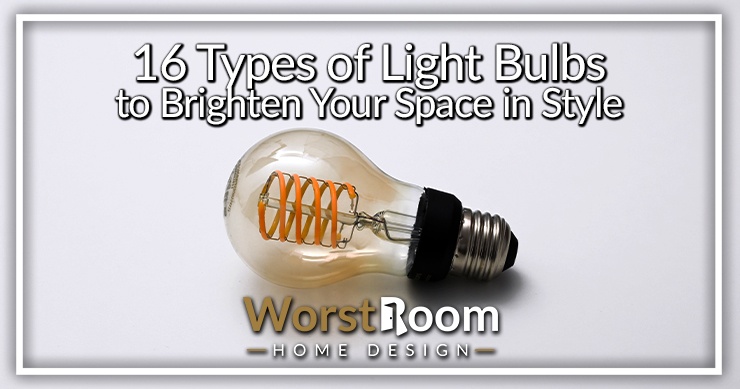
Thomas Edison and Joseph Swan did humankind a humongous favor when they invented what was probably the invention of the century—the humble light bulb. And now we have a lot of types of light bulbs available to us.
Two centuries later, these devices are still as relevant as the day they were created and have literally lit up many lives.
Though their relevance remains unchanged, light bulbs have far evolved from their original incandescent form. Today, bulbs exist in many shapes and forms, each one with its own levels of efficiency, way of functioning, light texture, light quality and functionality.
Given the aforementioned many shapes and forms (and throwing the many brands into the mix), something as simple as picking out a light bulb can quickly get not so simple.
16 Types of Light Bulbs
Don’t worry—we’re here to throw some light on the different types of light bulbs that are available in the market. Read on for a quick primer.
There are four primary types of light bulbs—light-emitting diodes (LED), incandescent, halogen, fluorescent and compact fluorescent (CFL) bulbs—which in turn have many types under them.
Light-Emitting Diodes (LED)
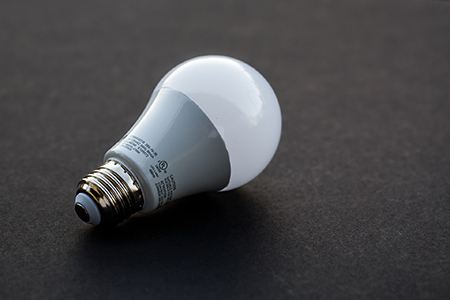
LEDs are everywhere, these days—from your torch to your vehicle to even your Christmas serial set. These are by far the most advanced and best bulbs out there that we should all slowly migrate over to.
The new kids on the block are popular for a reason—they’re the most energy-efficient light bulbs available, giving off surprisingly bright light on very little energy. These bulbs also come mercury-free, nor do they emit heat.
LEDs are great for task lighting, providing superb directional lighting. Some users may find the price tag a little steep but the low cost of running more than makes up for it. LEDs are also hard to break and won’t be starting any fires easily.
These lights are also very commonly used on stage to light plays, performances, especially because they come in a range of colors and not just white light, negating the need to use filters and gels, too.
However, such lights aren’t always dimmable and depending on which bulb you buy, you may find them to be dimmer than actual incandescent bulbs. Some types of LED light bulbs include:
Integrated LED: These are fixtures that have LED lights integrated or built into them. Such lights last extremely long hours (an impressive 50,000 hours, at least) and are ideal for spots that are hard to access.
Globe LED Bulbs: These bulbs are shaped like incandescent bulbs but contain LED technology, which means they’re more energy efficient and cost efficient. You can find these even in candelabra and pin type bases.
LED Strip Lights: As the name suggests, these are strips of LED types of light bulbs. These strips find common usage across a range of settings, from loading docks to gardens to garages. LED strips distribute light evenly owing to their acrylic lens and are great sources when you’re looking for lots of light.
LED Panels: LED panels are great if you’re looking for light that doesn’t flicker or dim accidentally. These are most commonly used in kitchens, but can also find usage in schools, stores, offices and other settings. LED panels make great types of track lighting.
Incandescent Light Bulbs
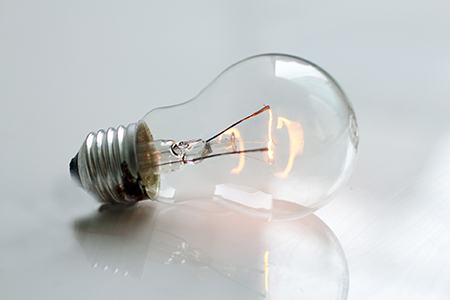
The original light bulbs, incandescent light bulbs are the most commonly used bulbs out there, due to their long history as well as their dirt-cheap prices.
These light bulb types are preferred for the warm light that they emit, their compatibility with dimmers and their long lives—they can last you up to a year (in reality the filaments tend to break way faster especially in homes or apartments with voltage spikes), which is much longer than their halogen counterparts.
Incandescent bulbs have a tungsten filament that glows when supplied with current from whatever types of light switches you have, surrounded by nitrogen gas or a vacuum around it.
These bulbs come in a range of shapes and sizes and are mercury-free. However, they’re not very energy efficient and are prone to heating and burning out from sudden current flows.
Halogen Light Bulbs
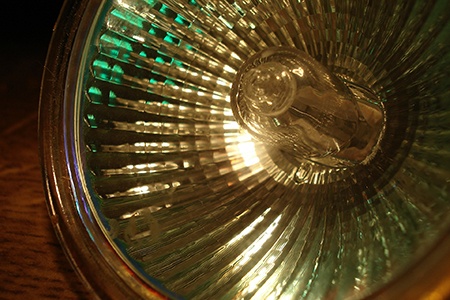
Halogen bulbs are one-up on traditional incandescent bulbs. These are distinguishable by the white light that they emit and are commonly used to light cabinets or in pendant lights and recessed lighting.
Halogen light bulbs get their name from the inert gas—the halogen mix that’s in them. The former increases the bulb’s lifespan as well as the brightness of the light.
Despite their energy efficiency and dimmable nature, they are the most short-lived bulbs of the lot. They’re also smaller than incandescent bulbs. Additionally, they heat up quite fast and could become fire hazards.
(Pro tip—use gloves to change these types of light bulbs as even the natural oil on your palms can cause an extremely heated halogen bulb to explode. Yep, they’re that sensitive.)
Fluorescent Light Bulbs
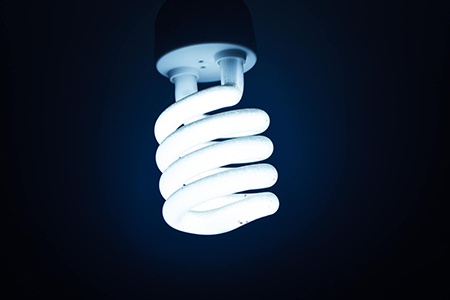
Fluorescent light bulb types are like the complicated choice of the light bulb world. In these bulbs, electric currents pass between the cathodes, activating the gasses and mercury inside into party mode, resulting in a ton of energy being created.
This energy translates into light when it interacts with the outer phosphorus coating. Fluorescent lamps use less energy than other bulbs to produce the same amount of light and can last you quite a while.
However, the fact that they’re chock full of mercury makes them less than ideal for disposal and the environment, leaving many people to seek fluorescent light alternatives.
There are many light bulb types of fluorescent lamps:
Tube Fluorescent Bulbs: These fall in the higher price range, but their long lives make up for it. These bulbs are strong light sources; however, they can’t be dimmed and tend to flicker with old age, warranting replacement.
Circular Fluorescent Bulbs: These emit light in a circular pattern. They're interesting when used in the right types of floor lamps without lamp shades.
Twisted Fluorescent Bulbs: These are very commonly seen and used—they’re both more energy efficient and longer living than incandescent bulbs. These are great in both residential and commercial settings and come in dim and bright versions.
Compact Fluorescent Light Bulbs
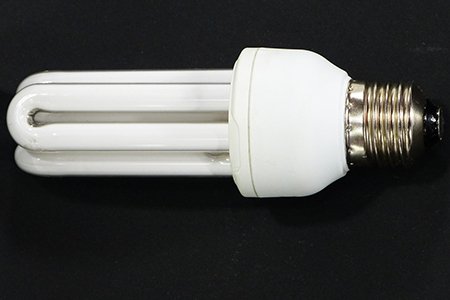
Compact fluorescent light bulbs, commonly called CFLs, are extremely energy efficient and come in a range of colors.
Though they are ultimately fluorescent lights (they work on the same principle but use less energy to do so), they deserve a section of their own for their efficiency, features and functionality.
CFLs get brighter as they get warmer, which can take a little time. They’re most commonly used in large spaces both commercial and residential, such as kitchens, basements and halls.
They are the less-expensive option when compared to LED bulbs (but still relatively expensive compared to others) and the more long-lasting option when compared to incandescent light bulbs—though they resemble incandescent bulbs, the similarities end there.
In fact, CFLs were designed to replace their incandescent cousins, lasting up to 10,000 hours—ten times more compared to the latter’s meager 1,000 hours.
Unlike the other bulbs, though, these bulbs contain mercury, so you want to be careful while handling them, probably not using them in any types of lamps that risk being knocked over.
However, these types of light bulbs are great for the environment because once they reach the end of their lives, they can be recycled, despite the mercury, in addition to lasting thousands of hours, emitting very little heat and being very energy efficient.
Mercury Vapor Bulbs
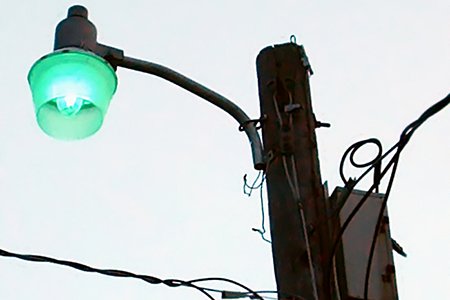
Though the word “mercury” may scare you, mercury vapor types of bulbs are excellent choices for overhead lighting, spotlights and outdoor lighting, thanks to the extremely bright and high-quality light they emit.
These bulbs are also energy efficient and last long periods (up to 24,000 hours), further adding to the allure.
Mercury vapor light bulb typess are, primarily, of two styles:
T Bulbs: These bulbs are self-extinguishing, shutting off within 15 minutes of the outer bulb breaking.
R Bulbs: R bulbs, on the other hand, are not self-extinguishing and therefore, should only be used in fully glass or plastic-enclosed types of light fixtures or in areas where there is no risk of UV radiation on the outer bulb breaking.
Though these bulbs are great while unbroken, they can be quite harmful when broken, radiation unshielded light and with it, UV radiation that can cause nausea, double or blurred vision, headaches and even burns to the skin and eyes hours from exposure.
So while they are legal, these require care and safety precautions. Because of this, you won't find these in any types of ceiling lights in your home or even around your home on the exterior.
Sodium Vapor Bulbs
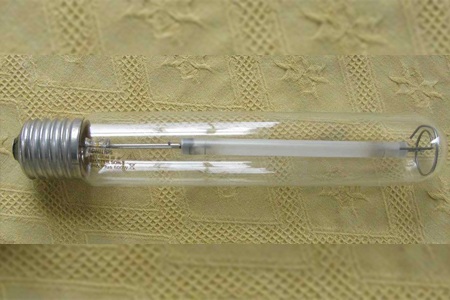
The name itself may sound unfamiliar to you, but you’re probably extremely familiar with these bulbs—they’re used in a range of outdoor settings, from street lamps to tunnel lights.
Sodium vapor bulbs contain solid sodium, neon and argon, which react to the current they receive and create lighting. As the bulb warms up, the light is pinkish or reddish and turns yellow when fully warmed (sodium, responsible for the yellow, is the last to vaporize).
Sodium vapor types of light bulbs come in two types:
High-Pressure Bulbs: These produce reddish-yellow light, compared to the monochromatic yellow than their low-pressure siblings produce. They’re also more energy efficient, produce light in all directions and contain mercury.
Low-Pressure Bulbs: Low-pressure bulbs emit only yellow light (or white light) but are more efficient than high-pressure bulbs, as the latter requires more parts and fixing to produce the desired lighting.
Sodium vapor bulbs are commonly used only for night lighting. They are the preferred outdoor choices since they can emit fog-penetrating light, last up to 50,000 hours, are energy efficient and emit a warm range of colors.
Reflectors
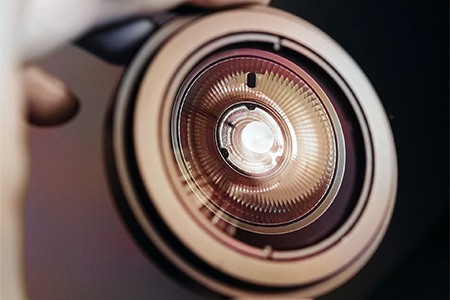
Reflector light bulb types have a silver surface that directs light to the specified area. These are great spotlights given their uni-directional lighting.
Flame-Shaped Bulbs
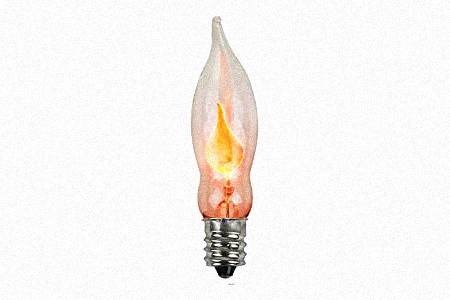
These retro types of bulbs are recognizable by their candlestick-like appearance, extremely common, once upon a time, in chandeliers and lamps across the country. These bulbs are cozy and look like actual candles and do a great job of combining aesthetic appeal and functionality.
Some flame-shaped bulb variants can be dimmed while others can’t, so consider this fact if you’re going to deck your new chandelier with these bulbs.
Types of Light Bulbs for Every Need & Purpose
Though light bulbs are extremely simple devices, the many types and modes of functioning can make things more complicated.
This is, in no way, an exhaustive list—there are also other bulbs such as spotlight bulbs, corn bulbs and diodes that aren’t covered in the list, but exist and are commonly used, too.
Hopefully, the next time you have to run down to the store to replace your broken bulb, the many aisles, types and names won’t confuse you; if they do, just whip out our handy guide on the types of light bulbs and you’ll quickly see the light at the end of the tunnel.
You'll Also Enjoy:
- 13 Types of Candles to Set the Perfect Mood & Ambience
- 16 Candle Alternatives That Still Provide Relaxing Scents & Great Light
- 12 Types of Ladders to Efficiently & Safely Get the Work Done
- 16 Types of Ceilings to Elevate & Enhance Your Space
- How to Make Your Living Room Cozy - 27 Ideas to Max Out Comfort



